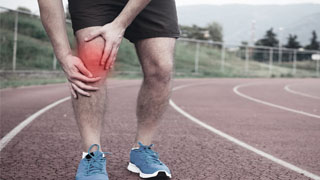
Facing the problem of knee valgus (also known as knee joint valgus), many people are deeply affected by the discomfort and self-image problems it brings. This common posture problem is often rooted in uneven distribution of muscle strength and poor daily posture habits, which may eventually lead to knee and even hip pain.
Fortunately, for mild knee valgus symptoms, you can effectively alleviate or even correct the problem at home by implementing precise exercise plans and lifestyle adjustments.
This article will provide a detailed explanation on how to use self massage techniques, scientific stretching exercises, and targeted strength training to address muscle imbalances that can cause knee valgus.
We will guide you step by step to unlock the corresponding solution, by relaxing the overly tight adductor muscles and strengthening the relatively weak abductor muscles, gradually rebuilding the balance between the two, thereby improving the normal arrangement structure of the knee joint and reducing various discomforts caused by it.
While following this series of guidelines, please be sure to maintain the standardization and gradual principle of exercise movements, as changing long-term physical problems requires time and persistent effort.
1、 Understand knee valgus
Knee valgus, also known as knee valgus, is a condition where the knees bend inward, causing them to touch or almost touch each other while keeping the feet apart, especially when standing or squatting, jumping or landing.
This alignment issue may cause pain, discomfort, and decreased mobility of the knees and hips. The main causes of knee valgus are usually muscle imbalance and poor posture, especially between the adductor and abductor muscles in the buttocks and thighs.
However, more severe cases may be caused by genetic factors, skeletal abnormalities, injuries, or certain medical conditions, which are not within the scope of this article's discussion.
II Understand muscle imbalance during knee valgus
In order to effectively solve the problem of knee valgus, it is necessary to understand the muscle imbalance that causes this condition. Knee inversion is usually caused by an imbalance between the adductor muscle (the muscle that pulls the leg inward) and the abductor muscle (the muscle that pulls the leg outward).
Leg abduction
In the case of knee valgus, the adductor muscle is usually tight and strong, while the abductor muscle is weak and relaxed. This unevenness can cause the knee to turn inward.
To correct these imbalances, you need to:
Massage and stretch tight adductor muscles to reduce tension and increase flexibility. To prevent tension, pull your knees inward.
Strengthen the weak abductor muscles, including the tensor fascia lata (TFL), gluteus medius, gluteus medius, and gluteus maximus, to counteract the inward tension of the tight adductor muscles.
By focusing on these two key aspects, you can strive to restore balance between the abductor and adductor muscles, ultimately improving knee eversion.
In the following sections, we will provide specific techniques and exercises to help you achieve this goal.
3、 Self massage of adductor muscles
Self massage techniques can help alleviate chronic tension in the adductor muscles. We will introduce two methods to relieve adductor tension: rolling with foam shaft and using massage ball.
Foam axis rolling adductor
Lie face down with the foam axis perpendicular to the thigh and close to the groin.
Bend your exercising leg to a 90 degree angle and place your feet flat on the floor.
Support yourself with the forearm and the foot of the other leg.
Slowly roll back and forth, applying pressure to the adductor muscles from the groin to the knee.
Spend more time on tight or sensitive areas, then repeat on the other leg.
Adductor massage ball release device
Place the massage ball on the ground and lie prone.
Place the ball on the inner thigh of your exercising leg, near the groin.
Bend your exercising leg and place your feet flat on the ground with your knees facing outward.
Gently roll the ball along the inner thigh, from the groin to the knee, pausing for 20-30 seconds in any tense area.
Repeat on the other leg.
4、 Stretching adductor muscles
Stretching and elongating the tight adductor muscles can help improve knee alignment and reduce knee eversion.
Standing side lunge stretching
Stand with feet apart, hip width apart, toes forward.
Bend your right knee, shift your weight to the right, and keep your left leg straight.
Place your hands on your right knee for support and keep your chest up.
Keep stretching for 30 seconds and feel a stretch on the inner side of the left thigh.
Repeat on the other side.
Sitting adductor muscle stretch
Sitting on the ground, legs extended in front of you.
Spread your legs to both sides as much as possible for maximum comfort.
Place your hands on the ground in front of you, tilt your torso forward, and keep your back straight.
Keep stretching for 30 seconds and feel the stretch on the inner thigh.
Frog style stretching
First, place your hands and knees on a yoga mat or soft surface.
Spread your knees to both sides and let your feet naturally turn outward.
Lower your hips towards the heel and place your hands on the ground for support.
Keep stretching for 30 seconds and feel the stretch on the inner thigh.
5、 Strengthen the abductor muscles
It is crucial to strengthen the weak abductor muscles, especially the gluteus, gluteus medius, and gluteus medius, in order to counteract the strong pulling force of the adductor muscles. Strengthening the gluteus maximus muscle at the same time is not harmful.
Clam shell style
Lie on your side, bend your legs 90 degrees, and bring your feet together.
Keep your hips folded and rest your head on your arm or pillow.
Slowly lift your knees towards the ceiling while keeping your feet together, then lower them.
Complete 10-15 times on each side, for a total of 3 groups.
Belt shaped side step
Place a resistance band around the ankle.
Stand with your feet apart, hip width apart, and knees slightly bent.
Walk one foot to one side, then the other foot, maintaining the tension of the elastic band.
Walk 10 to 15 steps in one direction, then change direction and walk 3 sets in the opposite direction.
Elastic band squat
Place a resistance band around the thighs and above the knees.
Stand with feet shoulder width apart and toes pointing forward.
Squat down and push your hips back to ensure that your knees do not sink inward.
Apply force to the heel and restore standing posture.
Complete 3 sets 10-15 times.
Lying sideways and lifting legs
Lie on your side, stretch your legs straight and fold them over each other.
Support the head with the lower arm or pillow.
Keep your upper legs straight and your feet bent, slowly lift them towards the ceiling, and then lower them.
Complete 10-15 times on each side, for a total of three groups.
6、 Preventive measures and other precautions
Consistency: Regularly perform these massage techniques and adductor muscle extensions; You may need some time to see the results.
Strengthening: Focus on strengthening the abductor muscles, especially the gluteus medius, through exercises.
Mindfulness: Pay attention to your posture during exercise, especially the position of your knees. For example:
Squat: Keep your knees in line with your toes and do not let your toes collapse.
Single leg lunge: Ensure that the knee is directly above the ankle, rather than collapsing inward.
Other factors: If you do not see improvement after consistently following these exercises and preventive measures, consider other posture impairments such as pelvic forward tilt or flat feet, which may cause your knees to turn outward.
main points
For mild knee valgus, a series of self-regulation methods can be used to improve it, including self massage therapy, stretching exercises, and targeted strength training. By soothing the tense adductor muscles and strengthening the relatively weak abductor muscles, the balance between these two groups of muscles can be gradually adjusted, thereby optimizing the alignment of the knee.
During the exercise process, it is important to adhere to the correct methods and maintain sufficient patience, as the correction process may take some time to show significant results.
Here is a special reminder that the recommendations provided in this article are mainly applicable to individuals with mild knee valgus symptoms. If your knee valgus problem is severe or persistent, it is strongly recommended to seek professional help in a timely manner, obtain professional evaluation opinions and personalized treatment plans.


